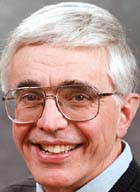Philip D. Stahl, Ph.D., the Edward Mallinckrodt Jr. Professor and head of the Department of Cell Biology and Physiology in the School of Medicine, has been named chair of the Division of Biology and Biomedical Sciences (DBBS).
Ralph S. Quatrano, Ph.D., the Spencer T. Olin Professor and chair of the Department of Biology in Arts & Sciences, will serve as co-chair until June 30, 2005, at which point he will take over as chair of the division.
Stahl and Quatrano replace Jeffrey I. Gordon, M.D., the Dr. Robert J. Glaser Distinguished University Professor and head of the Department of Molecular Biology and Pharmacology and professor of medicine, who served as chair of the division for the past decade.
“Jeff has done a wonderful job organizing the structure of the division, and he has infused a great deal of enthusiasm and esprit de corps into the organization,” said Stahl, who was chair of the division from 1989-1992. “I’m very excited to have the opportunity to continue his leadership of this critical and exemplary program.”

The DBBS houses most graduate programs in the biomedical sciences. Founded in the early ’70s, it has become the national model for graduate education in biology and biomedical sciences through its interdisciplinary degree programs.
“The division was begun with the recognition that science was not being done along departmental boundaries,” said John H. Russell, Ph.D., associate dean for graduate studies and professor of molecular biology and pharmacology. “In fact, we think the best science is done at the edges of boundaries. So we restructured our graduate education approach in an effort to break down departmental boundaries and promote interactions within the University’s scientific community.”
As chair, Stahl hopes to focus on three key aspects of graduate education. First, he plans to encourage the interface between physical and biological sciences, a goal that mirrors one of the national science community’s recent objectives. He also hopes to foster interactions between undergraduate and graduate programs at the University.
According to Russell, the partnered leadership between Stahl on the Medical Campus and Quatrano on the Hilltop Campus provides a unique and hopefully effective way to address these two areas.
Third, Stahl plans to promote the interface between biological and clinical sciences within the graduate student community. As one of the key figures planning the new Farrell Learning and Teaching Center, a structure soon to be housed on the Medical Campus as a space for medical and graduate education, Stahl is already focused on this particular endeavor.
“We have an opportunity to create the kind of interface between and among students that will stimulate creative thinking across disciplines, because that’s where the future is — collaboration,” Stahl said.
In addition to his leadership in the division and in the development of the Farrell Learning and Teaching Center, Stahl is also recognized for his investigations into the mechanisms involved in endocytosis, the process through which cells absorb external substances such as proteins. He now is studying endocytosis and signal transduction in cancerous cells in an effort to understand how growth signals are internalized into cells.

In addition, he is investigating the ways in which pathogens and cellular debris are transported to sites inside cells where they can be broken down and destroyed.
Stahl earned a bachelor’s degree in 1964 from West Liberty State College and a doctorate in 1967 from West Virginia University. In 1971, after completing postdoctoral training at the University of Missouri and Vanderbilt University, Stahl joined the Washington University faculty.
He was a senior international Fogarty Foundation fellow at Oxford University from 1980-81.
Stahl has received many awards and honors for his scientific contributions, and recently became a fellow of the American Association for the Advancement of Science (AAAS). He also is the 2003 recipient of the Women in Cell Biology Senior Recognition Award given by the American Society for Cell Biology.
Quatrano, who also was recently named as a fellow of the AAAS, is internationally known for his plant science work on patterns of embryo formation and how the patterns lead cells to acquire traits or characteristics of the mature embryo during seed development. His basic models include algae and embryos of developing cereal seeds.
Quatrano earned a bachelor’s degree in botany with honors from Colgate University in 1962; a master’s in botany from Ohio University in 1964; and a doctorate in biology from Yale University in 1968.
His expertise has resulted in a distinguished career at outstanding universities (Oregon State University, 1968-1986; and the University of North Carolina, 1989-1998; plus numerous visiting appointments) and in industry, authorship of more than 130 scholarly articles and editorial positions with outstanding journals, including editor in chief of the premier plant science journal, The Plant Cell.
“Jeff Gordon has really helped the division flourish,” Russell said. “Under his leadership, our enrollment has doubled and we have been able to increase stipends accordingly so that we can stay competitive.
“Phil Stahl and Ralph Quatrano are the perfect successors to carry on the division’s goal of graduate training excellence through collaboration and cooperation across departmental lines.”